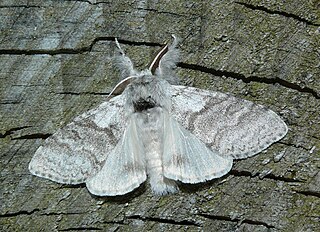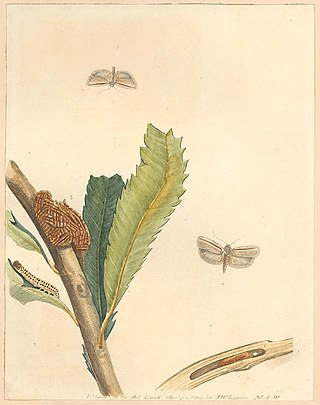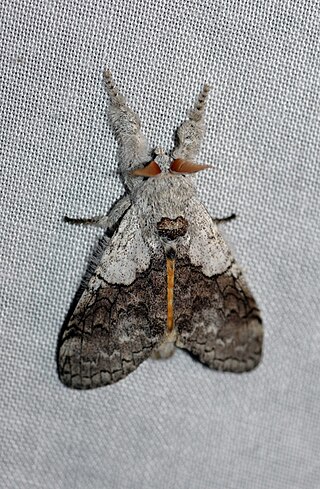
Hypena is a genus of moths in the family Erebidae. It was first described by Franz von Paula Schrank in 1802. These non-migratory moths overwinter as pupae and almost never estivate as adults.

Calliteara pudibunda, the pale tussock, is a moth of the family Erebidae. The Dutch common name for the moth (Meriansborstel) comes from the butterfly and insect painter Maria Sibylla Merian. The species was first described by Carl Linnaeus in his 1758 10th edition of Systema Naturae. It is found in Asia and Europe.
Chamyna is a genus of moths of the family Erebidae. The genus was erected by Jacob Hübner in 1821.

Calliteara is a genus of tussock moths in the family Erebidae. The genus was erected by Arthur Gardiner Butler in 1881.

Imaus is a genus of tussock moths in the family Erebidae. The genus was erected by Frederic Moore in 1879.

Locharna is a genus of tussock moths in the family Erebidae. The genus was erected by Frederic Moore in 1879.

Mahoba is a genus of moths in the subfamily Lymantriinae. The genus was erected by Frederic Moore in 1879.

Calliteara kikuchii is a moth of the family Erebidae first described by Shōnen Matsumura in 1927. It is found in Taiwan.

Calliteara lunulata is a moth of the family Erebidae. It is found in the Russian Far East, Japan, China and Taiwan.

Calliteara arizana is a moth of the family Erebidae first described by Alfred Ernest Wileman in 1910. It is found in Taiwan.
Calliteara albibasalis is a moth of the family Erebidae first described by William Jacob Holland in 1893. It is found in Gabon.

Calliteara baibarana is a moth of the subfamily Lymantriinae first described by Shōnen Matsumura in 1927. It is found in Taiwan.

Phalacra strigata is a species of moth of the family Drepanidae first described by Brisbane Charles Somerville Warren in 1896. It is found in India, China and Taiwan.

Calliteara fortunata is a moth of the family Erebidae first described by Alois Friedrich Rogenhofer in 1891. It is found on the Canary Islands.
Teleclita strigata is a moth of the family Notodontidae first described by Frederic Moore in 1879.
Teleclita is a genus of moths in the family Notodontidae. The genus was described by Turner in 1903.
Calliteara flavobrunnea is a moth of the family Erebidae. It was described by Robinson in 1969. It is found on Fiji.

Xylorycta strigata, the banksia web-covering borer, is a moth in the family Xyloryctidae. It was described by John Lewin in 1805. It is found in Australia, where it has been recorded from New South Wales, Queensland and South Australia.

Calliteara horsfieldii, or Horsfield's tussock moth, is a moth of the family Erebidae. The species was first described by the British entomologist Edward Saunders in 1851, and named in honor of the British naturalist Thomas Horsfield, who traveled southern Asia and published works on zoology from the region. C. horsfieldii can be found in southern Asia, the islands of the northern Indian Ocean, and many parts of south east Asia and Indonesia. It is also sometimes referred to as the Yellow Tussock Moth.














